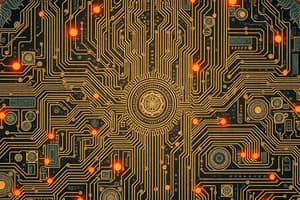Podcast
Questions and Answers
What type of signals does analog electronics deal with?
What type of signals does analog electronics deal with?
- Pulsating signals
- Continuous signals (correct)
- Frequency signals
- Digital signals
Which component is used to resist the flow of electric current in analog circuits?
Which component is used to resist the flow of electric current in analog circuits?
- Capacitors
- Inductors
- Voltage dividers
- Resistors (correct)
What is the purpose of a resistive voltage divider circuit in analog electronics?
What is the purpose of a resistive voltage divider circuit in analog electronics?
- Store and release electrical charge
- Create time-varying amplitude signals
- Match impedance in circuits
- Produce a voltage proportional to resistance values (correct)
What do capacitors store and release in analog circuits?
What do capacitors store and release in analog circuits?
In an RC circuit, what determines the time constant of the circuit?
In an RC circuit, what determines the time constant of the circuit?
What is the primary function of inductors in analog circuits?
What is the primary function of inductors in analog circuits?
What is the main function of amplifiers in analog circuits?
What is the main function of amplifiers in analog circuits?
Which component allows current to flow in one direction and blocks it in the other?
Which component allows current to flow in one direction and blocks it in the other?
What is the function of mixers in analog circuits?
What is the function of mixers in analog circuits?
Which analog circuit component is used to selectively pass or reject certain frequencies in a signal?
Which analog circuit component is used to selectively pass or reject certain frequencies in a signal?
In analog electronics, what is the main purpose of an operational amplifier (op-amp)?
In analog electronics, what is the main purpose of an operational amplifier (op-amp)?
What do detection and modulation circuits do in analog electronics?
What do detection and modulation circuits do in analog electronics?
Study Notes
Analog Electronics
Analog electronics is a crucial aspect of electronic systems and devices. It deals with the operations of continuous signals, as opposed to the discrete signals in digital electronics. Analog electronics is used in a wide range of applications, from audio and video systems to communication networks and control systems.
Components of Analog Electronics
Analog electronics components include:
-
Resistors: These are passive components that resist the flow of electric current. They can be used in various analog circuits, such as voltage dividers, current dividers, and voltage regulators.
- Resistive Voltage Divider: This circuit is used to produce a voltage that is proportional to the resistance values of the resistors in the circuit. The voltage division ratio is determined by the resistance values of the components.
-
Capacitors: These components store and release electrical charge. They are used in circuits to filter signals, store energy, and provide timing functions.
- RC Circuit: This is a simple circuit consisting of a resistor and a capacitor in series. The time constant of the circuit is determined by the product of the resistor and capacitor values.
-
Inductors: These components store energy in a magnetic field created by the flow of electric current. They are used in circuits to filter signals, provide impedance matching, and create signals with a time-varying amplitude.
-
Amplifiers: These active components increase the amplitude of a signal. They are used in various analog circuits, such as voltage amplifiers, current amplifiers, and operational amplifiers.
- Operational Amplifier (Op-Amp): This is a versatile component that can be used in various applications, such as voltage follower, inverter, summing amplifier, and integrator.
-
Diodes: These components allow current to flow in one direction and block it in the other. They are used in rectifiers, voltage regulators, and switching circuits.
Analog Circuits
Analog circuits are used to process continuous signals. Some common analog circuits include:
-
Amplifiers: These circuits increase the amplitude of a signal. They can be used to amplify signals for further processing or to provide a larger output for measurement.
-
Mixers: These circuits combine two signals to produce a third signal. They are used in communication systems to combine a carrier signal with an information-carrying signal.
-
Filters: These circuits selectively pass or reject certain frequencies in a signal. They are used to remove unwanted noise, isolate specific frequencies, and shape the frequency response of a system.
-
Oscillators: These circuits generate a signal that repeats with a specific frequency. They are used in communication systems, timing circuits, and control systems.
-
Detection and Modulation: These circuits convert digital signals into analog signals or vice versa. They are used in communication systems, data acquisition systems, and control systems.
Conclusion
Analog electronics is a vital aspect of electronic systems and devices. It deals with the processing of continuous signals and is used in a wide range of applications. Understanding analog electronics is crucial for designing and understanding electronic systems.
Studying That Suits You
Use AI to generate personalized quizzes and flashcards to suit your learning preferences.
Description
Test your knowledge on resistors, capacitors, inductors, amplifiers, diodes, and common analog circuits such as amplifiers, mixers, filters, oscillators, and modulation circuits. Learn about the fundamental components and their applications in analog electronics.




